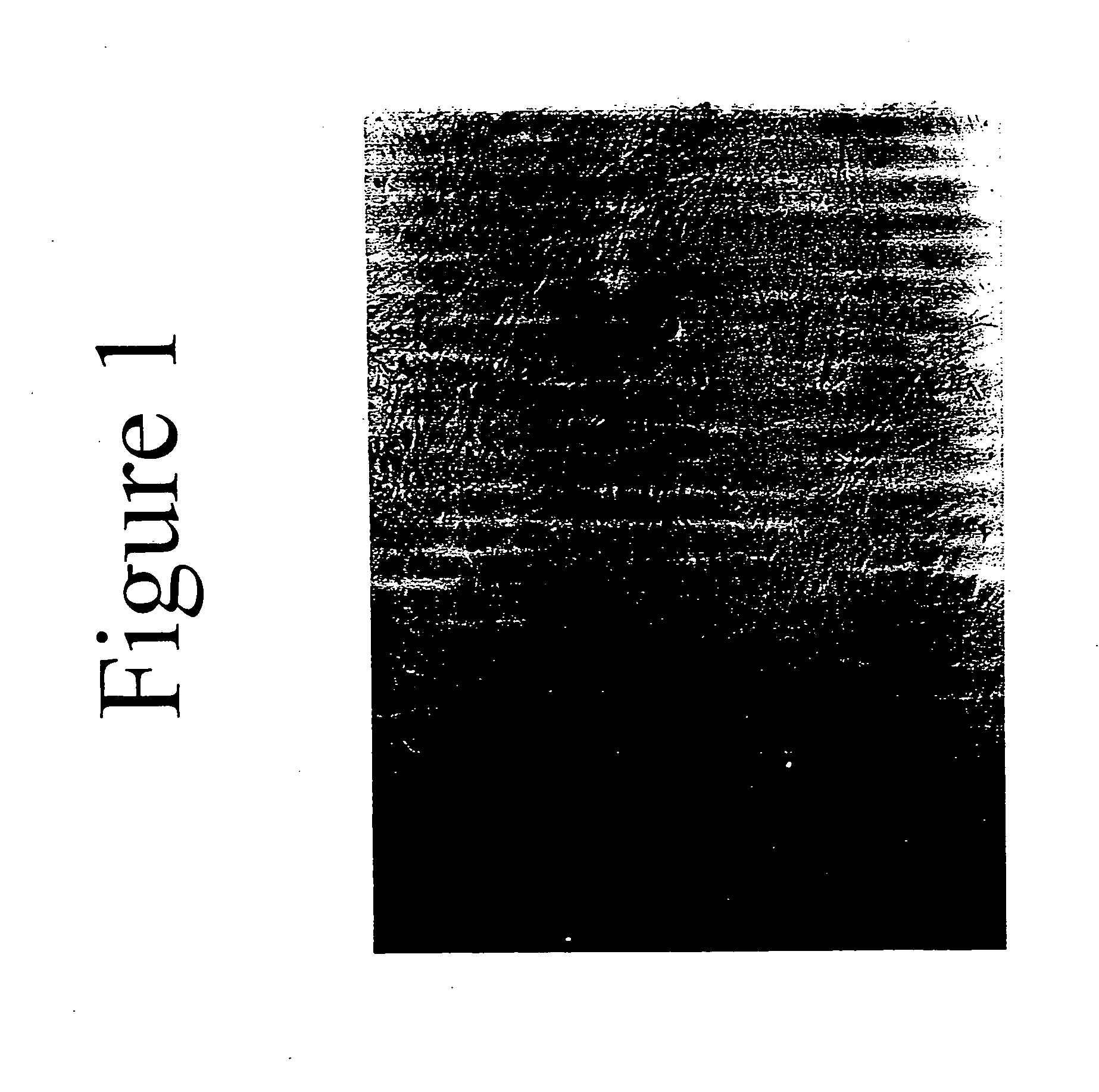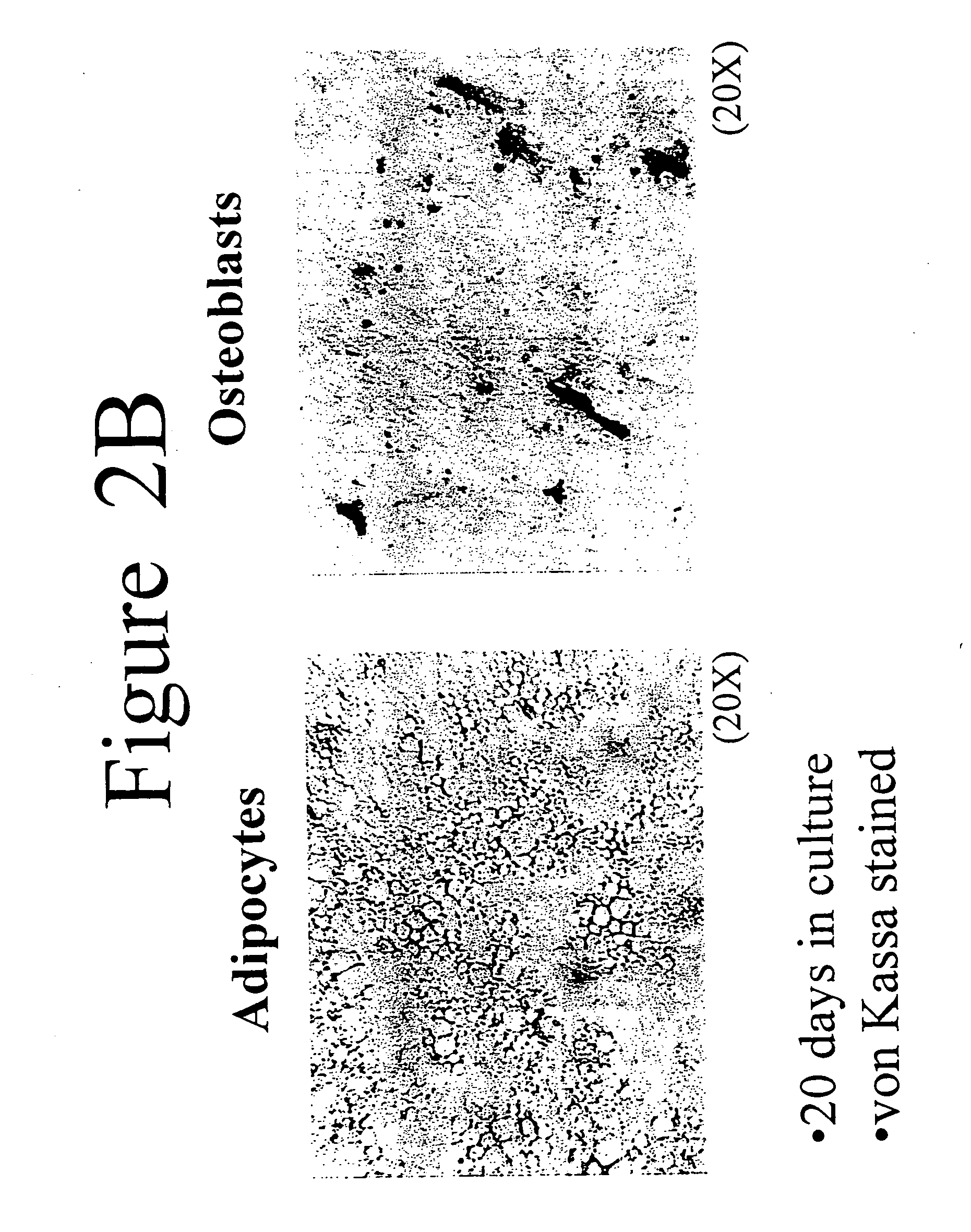Differentiation of adipose stromal cells into osteoblasts and uses thereof
a technology of stromal cells and osteoblasts, which is applied in the field of differentiation of stromal cells from adipose tissue into osteoblasts, can solve the problems of increased care costs, significant issues associated with autografts, and lack of adequate supply for large wounds or defects, and achieve the effect of improving the bone structure of subjects
- Summary
- Abstract
- Description
- Claims
- Application Information
AI Technical Summary
Benefits of technology
Problems solved by technology
Method used
Image
Examples
example i
Isolation of Stromal from Human Adipose Tissue
[0040] Human stromal cells were isolated from adipose tissue according to the procedures described by Rodbell (1964) J Biol Chem 239:375 and Hauner et al. (1989) J Clin Invest 84:1663-1670. Briefly, human adipose tissue from subcutaneous depots was removed by liposuction surgery. The adipose tissue was then transferred from the liposuction cup into a 500 ml sterile beaker and allowed to settle for about 10 minutes. Precipitated blood was removed by suction. A 125 ml volume (or less) of the tissue was transferred to a 250 ml centrifuge tube, and the tube was then filled with Krebs-Ringer Buffer. The tissue and buffers were allowed to settle for about three minutes or until a clear separation was achieved, and then the buffer was removed by aspiration. The tissue was washed with Krebs-Ringer Buffer an additional four to five times or until it was orange-yellow in color and the buffer was light tan in color.
[0041] The cells of the adipose...
example 2
Differentiation of Extramedullary Adipose Stromal Cells Into Osteoblasts
[0043] Adipose stromal cells were isolated as described in Example 1 and then treated as follows to induce differentiation into osteoblasts. Stromal cells were plated in 24-well and / or 6-well tissue culture plates in stromal cell medium (see above) at a density of about 22,000 cells / cm2. After 24 hours, the stromal cell medium was replaced with osteoblast differentiation medium (DMEM with 10% fetal bovine serum (v / v); 10 mM β-glycerophosphate; 50 μg / ml ascorbate-2-phosphate; 60 U / ml penicillin; 60 U / ml streptomycin; 15 82 g / ml amphotericin B). The osteoblast differentiation medium was replaced with fresh medium every 3 days for 3 weeks. When changing the media, one ml of conditioned media was collected and stored at −80° C. for later analysis of secreted factors. Alternatively, stromal cells isolated from adipose tissue were induced to differentiate into adipocytes according to the method of Hauner et al. (1989...
example 3
Identification of Compounds Affecting Osteoblast Differentiation
[0051] Cultures of stromal cells isolated from adipose tissue according to the method described in Example 1 were used to study the effect compounds of interest on osteoblast differentiation. Osteoblasts were differentiated from adipose stromal cells as in Example 2, but in the presence and absence of a compound of interest. Differentiation was measured by assays for secreted osteocalcin. Compounds found to positively affect osteoblast differentiation using the method of this example include bone morphogenetic protein 4 and osteopontin-I (data not shown). These results are in agreement with the previous findings of Wozney et al. 1988 Science 242:1528-1534;.Asahina et al. 1996 Exp Cell Res 222:38-47; and Cook et al. 1996 Clin Orthop. 324:29-38. Compounds that enhance osteoblast differentiation may be used to enhance the bone structure of a subject, as discussed below.
PUM
| Property | Measurement | Unit |
|---|---|---|
| volume | aaaaa | aaaaa |
| volume | aaaaa | aaaaa |
| cell density | aaaaa | aaaaa |
Abstract
Description
Claims
Application Information
 Login to View More
Login to View More - R&D
- Intellectual Property
- Life Sciences
- Materials
- Tech Scout
- Unparalleled Data Quality
- Higher Quality Content
- 60% Fewer Hallucinations
Browse by: Latest US Patents, China's latest patents, Technical Efficacy Thesaurus, Application Domain, Technology Topic, Popular Technical Reports.
© 2025 PatSnap. All rights reserved.Legal|Privacy policy|Modern Slavery Act Transparency Statement|Sitemap|About US| Contact US: help@patsnap.com



